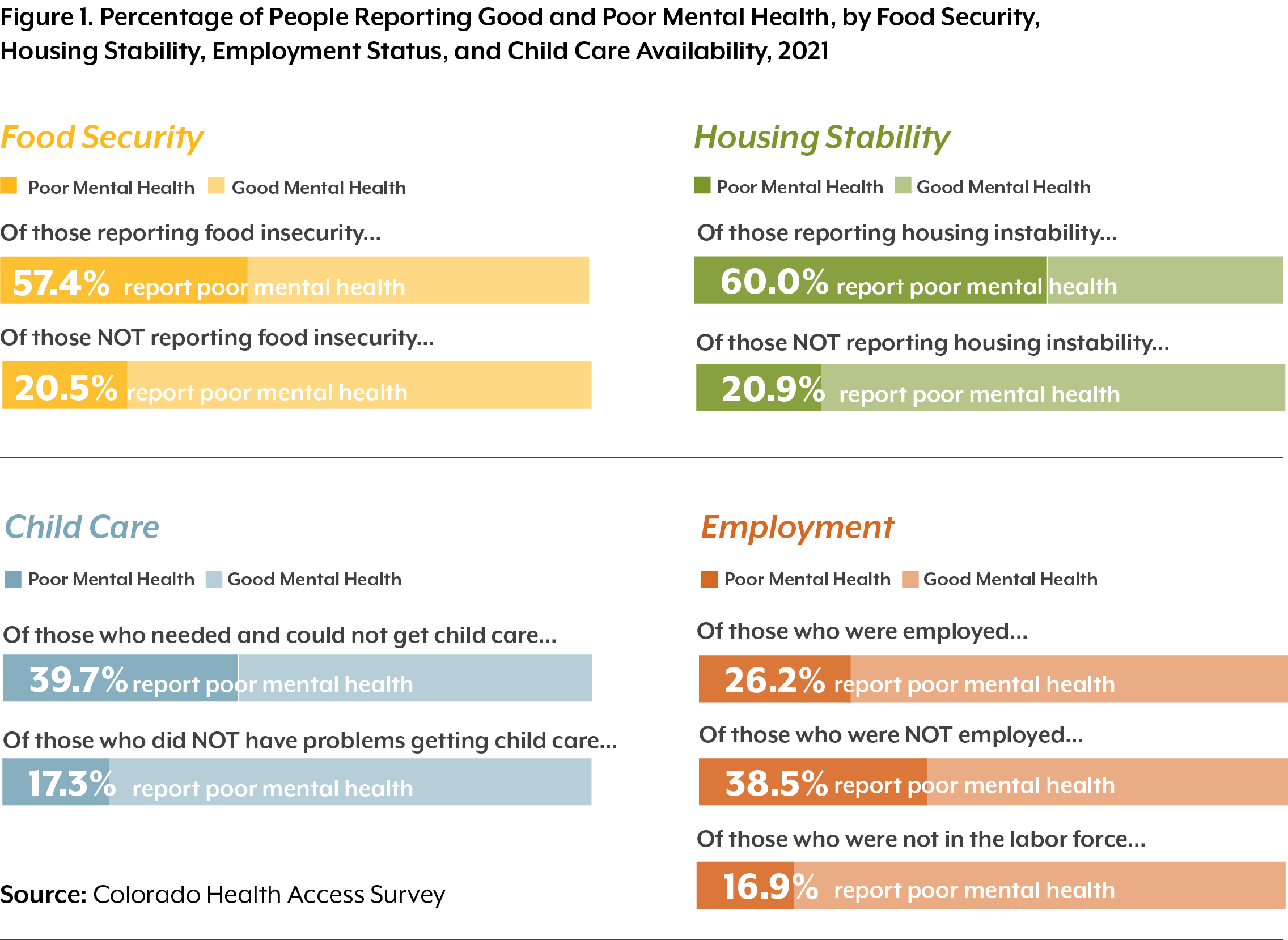Food Security
One in 12 Coloradans (8.1%) said they didn’t eat as much as they thought they should in the past year because they couldn’t afford food. The unmet need for food can be a major stressor, with 57.3% of people who needed food reporting poor mental health. That compares to 20.5% of people who had adequate food and were in poor mental health.
Housing Stability
Statewide, 5.6% of Coloradans worried about having a place to live in the next two months. Of those, 60.0% reported they were in poor mental health — three times the rate of people who were not worried about where they would live.
Employment
About two-thirds of the Colorado population ages 16 and up (65.1%) was employed when the CHAS was conducted, while 8.8% were unemployed. The remaining 26.1% were not in the labor force. This final category includes students, retirees, and people who do unpaid work.
People who were looking for a job were more likely to report poor mental health than those who had a job (38.4% to 26.2%). But the group least likely to report poor mental health was people not in the labor force. Just 16.9% of this group reported poor mental health — well below the state average of 23.7%. This group includes retirees and others who do not need to work, which could partially account for better mental health outcomes.
Child Care
Some 200,000 Coloradans went at least a week in the past year when they needed child care but could not find it. That’s almost one in 10 parents and guardians in Colorado (9.0%). Of those, four in 10 (39.7%) reported they were in poor mental health, compared to less than two in 10 (17.3%) parents and guardians whose child care needs were met.
What the CHAS Tells Us, and What It Doesn’t
Surveys like the CHAS can show correlation of data points, but they cannot prove causation. Challenges in any of the areas discussed in this analysis often go hand-in-hand with other social stressors, such as limited incomes or discrimination.
For example, parents who couldn’t find child care might have reported poor mental health because of the lack of child care, or because of a third factor, such as poverty, that contributed to both the lack of child care and poor mental health.
Finally, the four questions about social factors cannot explain all mental health challenges for Coloradans. At most, only one in five people in poor mental health reported troubles meeting these social needs. There is often a biological basis for mental illness, which is not examined in the survey.
In a separate project called Root Causes, CHI created a statistical model to estimate the contributions of various social factors on mental health, including influences such as sleep and time spent commuting. The Root Causes project includes interactive graphics and maps that allow Coloradans to explore these conditions statewide and in their own region.
Conclusion
These CHAS findings point to exciting possibilities for addressing mental health. Efforts to improve housing affordability, food security, job opportunities, and child care availability could pay dividends in improved mental health for Coloradans.
But it will require cooperation by agencies that are not necessarily accustomed to working with each other. Colorado’s state government has separate entities to address the social factors in this blog post:
- Mental health: The new Behavioral Health Administration, Department of Health Care Policy & Financing, and Office of Behavioral Health.
- Jobs: The Department of Labor and Employment.
- Food: The Department of Human Services.
- Child care: The new Department of Early Childhood.
- Housing: The Division of Housing.
These functions are rightly separated, because they require specialized knowledge and are governed by different sets of laws. But by drawing on expertise of these agencies in addressing social needs — and other at all levels of government and in the private sector — Colorado can make a more comprehensive and cohesive effort to improve mental health. The new Behavioral Health Administration will have a seat in the governor’s cabinet, which is an ideal position to advocate for the importance of mental health across the state government.
At the same time, the legislature and state agencies will make major investments in social services, employment, and child care this year, using billions of dollars from stimulus bills Congress passed in 2020 and 2021. Coupled with the launch of the new Behavioral Health Administration, the infusion of funding presents a golden opportunity to rethink the way Colorado’s policies and programs consider mental health.



